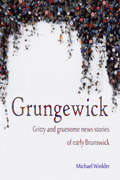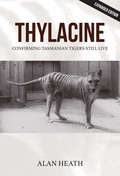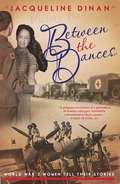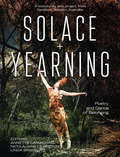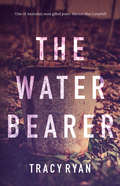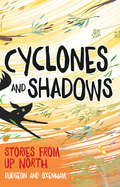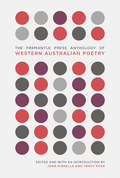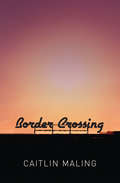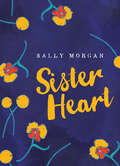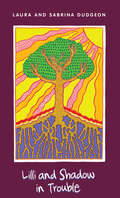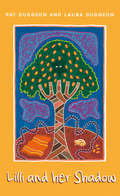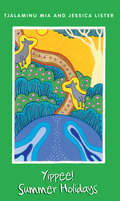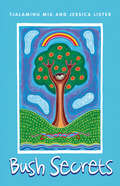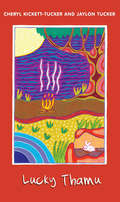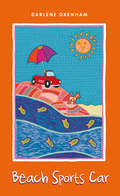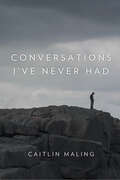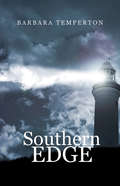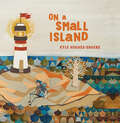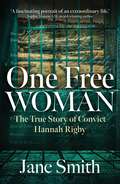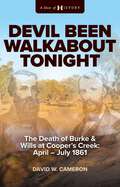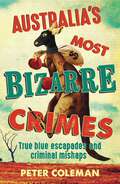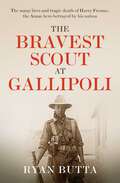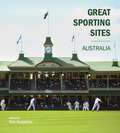- Table View
- List View
Grungewick
by Michael WinklerMurder. Mayhem. Misdeeds. In the nineteenth century, Brunswick was a satellite suburb of Melbourne. While the big city boomed, Brunswick was a place of "bricks and pottery, mud and poverty" with the unruliness of a frontier town. This collection of contemporary newspaper stories provides a vivid picture of the seamy side of life in 1800s Brunswick. It includes famous outrages such as the trial and execution of 'baby farmer' Frances Knorr; Mary Ryckman attacking her neighbour with dynamite; and the outbreak of Irish sectarian violence in Sydney Road. It also captures lesser-known incidents that, together, portray a much harder time: street larrikins, pub brawls, industrial deaths, poisoning both accidental and deliberate. Grungewick provides an unusual window into Australian life in the 1800s and shows that, even when times are toughest, the dignity and resilience of everyday people can shine through.
Thylacine
by Alan HeathThis book details how, in November 1993, during a holiday in northern Queensland, the author was first told by a witness to a Thylacine (Tasmanian Tiger), on Cape York Peninsula. It also details some of the many other Thylacine sightings on mainland Australia and in Tasmania that he has been told about up until 2014. The author wrote this book at the suggestion of an academic working at a Queensland university, after the author told the academic about some of the Thylacine sightings that he had been told about in Queensland.
Between the Dances
by Jacqueline DinanThe start of World War 2 changed women's lives and their place in Australian society forever. Thousands of women ventured where few had gone before - into the services and workplaces previously considered the sole preserve of men. In preparation for her book Between the Dances, Jacqueline Dinan, interviewed over three hundred women around Australia to collect the last first hand stories from World War 2. Revealing poignant and personal conversations, photographs and letters, Between the Dances is a testament to real life during World War 2. From Malta to Australia, New Zealand to the UK, the challenges and adventures faced by these women were unprecedented. Their passion, courage, resilience and commitment during wartime were all a precursor to the astonishing changes brought about by this incredible generation. For the first time, women were doing their bit as nurses in war zones, members of the services, farmhands, factory workers or volunteers in community service. The last tradition left was the weekly dance, which ceremoniously brought these courageous women and men together for a quickstep, fox trot and brief respite from the rigours of wartime. The accounts are enhanced by poignant, amusing and insightful anecdotes along with scores of previously unpublished and unique photographs from personal albums. Jacqueline's former experience was in corporate and art communications and events, before she embarked on her own public relations and events business. Now a regular speaker with the Country Women's Association, Australian Rotary Clubs, Legacy, Red Cross and Memorial groups, Jacqueline has become a well-known figure amongst The Returned & Services League of Australia.
Solace + Yearning – Poetry of Dance and Belonging: A Community Arts Project from Denmark, Western Australia
by Annette Carmichael‘Solace + Yearning’ layers landscape, poetry, eco-art and contemporary dance to create an immersive space for many voices: yearning to connect to country, grief for what is absent, and reaching towards an understanding of indigenous language and culture. “Along the edges, voices call softly, softly… the past speaking to the present.” This multi-arts collaboration explores ‘settler guilt’ and ‘solastalgia’—a sense of loss caused by environmental change—in a small rural community. The work unravels contradictory and complicated feelings about Australia’s stories, the assumed advantage of non-indigenous Australians, and yet our deep longing for the wisdom and connection intrinsic in indigenous cultures. “It is beneath the bark where stories are whispered and life rises to stitch together this river with this sky.” Performed in Denmark, Western Australia in 2012, and again as a solo performance by Annette Carmichael in 2014, these images and reflections portray a complex relationship between people and place. “Sometimes, sometimes I make the mistake of thinking that what has not been written down has been forgotten.” With gratitude to Joey Williams, Wayne Webb, Toni Webb, and Harley Coyne, who walked the trail with us and generously shared their Noongar culture and stories.
The Water Bearer
by Tracy RyanWater is contained in these poems in many different ways: from the water filling a second-hand cooler in an old farmhouse to ocean riptides and impassive dams; from swimming lessons to paddocks layered with water after rain. From scheme water, pipelines and a countryside in the grip of drought – the water in this collection is a many-sided metaphor. Tracy Ryan's latest collection of poems is full of intimate intensity and clear vision, each poem wrought with consummate skill by "one of Australia's most gifted poets" (Marion May Campbell).
Cyclones and Shadows: Stories from Up North
by Darlene Oxenham Pat Dudgeon Laura Dudgeon Sabrina DudgeonThis collection draws together four tales for younger readers from the Waarda series of Indigenous stories, first edited by acclaimed author Sally Morgan. Two stories feature Lilli and her magical companion, Shadow. The next two stories are about Annie, who learns how important ingenuity and strong family ties are when living in the remote community of Useless Loop. Drawing on the authors' own experiences, these charming tales are illustrated with black-and-white line drawings, and are a great way to introduce young readers to the world of contemporary Indigenous storytelling.
The Fremantle Press Anthology of Western Australian Poetry
by John Kinsella Tracy RyanThe Fremantle Press Anthology of Western Australian Poetry is a comprehensive survey of the state's poets from the 19th century to today. Featuring work from 134 poets, and including the work of many WA Indigenous poets, this watershed anthology brings together the poems that have contributed to and defined the ways that Western Australians see themselves.
Border Crossing
by Caitlin MalingCaitlin Maling's second volume, Border Crossing, continues to showcase the development of an exciting new voice in Australian poetry. Now Maling's poems shift from the first volume's gritty treatment of childhood and adolescence growing up in WA, to a consideration of what it is to be an Australian in America, where the conflicting voices and identities of home and abroad jostle against and seek their definitions from each other. In this volume, as in the first, her emphasis on place – geography and environment – is as strong as ever.
Sister Heart
by Sally MorganA young Aboriginal girl is taken from the north of Australia and sent to an institution in the distant south. There, she slowly makes a new life for herself and, in the face of tragedy, finds strength in new friendships. Poignantly told from the child's perspective, Sister Heart affirms the power of family and kinship. This compelling novel about the stolen generations helps teachers sensitively introduce into the classroom one of world's most confronting histories.
Lilli and Shadow in Trouble
by Laura Dudgeon Sabrina DudgeonThis is the second book to follow the adventures of Lilli—a young girl who has moved from the Australian bush to the city—and her magical animal friend, Shadow. While on holiday visiting family in the bush, Lilli discovers that Shadow is fading. Someone, or something, has taken over Shadow’s home in the old mango tree and Shadow is scared. With Lilli’s help, and with some assistance from Nan, they find the best solution for everyone, including the mango tree creature. Inspired by the art of Aboriginal storytelling, this charming read is sure to entertain junior readers.
Lilli and Her Shadow
by Pat Dudgeon Laura DudgeonLilli’s family is moving from the outback to the city, and Lilli is sure she'll be horribly lonely. She'll miss the mangoes, she'll miss her cousins, and most of all, she'll miss her Grandma. But when Grandma sends a special friend south with her granddaughter—a secret Shadow to look after her—Lilli discovers life in the city isn't so bad after all.
Yippee! Summer Holidays
by Tjalaminu Mia Jessica ListerDebbie and Billy just love the summer holidays, especially when their grandfather comes to stay. They have lots of fun racing tires, telling stories, and discovering the secret places Dada Kean knows about. A beautifully illustrated Aboriginal book, this entertaining modern-day fable underscores the importance of family and caring for the environment.
Bush Secrets
by Tjalaminu Mia Jessica ListerDebbie has two special secrets, and she doesn't want to share them with her brother Billy; however, when her grandfather, Dada Keen, comes to visit, Sally knows she can trust him. Debbie shows the treasure she found, the speckled eggs in the "Gorgemas Tree," and Dada Keen shows Debbie a special place in the bush. The interaction between Debbie and her grandfather strengthen the ideas of keeping secrets in order to preserve and protect the plants and animals that exist in our environment and sharing secrets with those who will respect and preserve our treasures. It is a beautiful tale of family and passing on the knowledge needed to help protect our environment.
Lucky Thamu
by Cheryl Kickett-Tucker Jaylon TuckerThis series explores the richness and depth of Indigenous storytelling During the school holiday, for the first time, Eli is going by himself to visit his grandfather, Thamu to go camping and prospecting. Eli loves being with Thamu, listening to his stories and learning about the country. Thamu knows lots about everything—but does Thamu know where to find gold, and will Eli will strike it lucky?
Beach Sports Car
by Darlene OxenhamWhen Annie’s dad promises her a beach sports car, she imagines a bright red hotrod with racing stripes. All her school friends will be so jealous! But when her gift turns out to be Dad’s battered old bomb car instead, Anne realizes it will take a lot of effort to turn it into the automobile of her dreams. Highlighting the power of imagination in making things new again, this entertaining story also shows how hard work can sometimes make the final reward that much sweeter.
Conversations I've Never Had
by Caitlin MalingCaitlin Maling's first collection is at heart a poetry of place. Cervantes, Donnelly River, Yallingup, Fremantle, Leonora, and beyond are richly evoked in poems ranging stylistically from accomplished mature lyrics and the confessional to narratives of raw power and feeling. Restlessly questioning and frequently allusive, slipping between promise and possibility, Maling's poems are invested in the actuality of the world, exploring the landscapes of memory and the brief moment of now.
Southern Edge
by Barbara TempertonIn this collection of three long narrative poems, Temperton conjures up the highs and lows of the coastal environment to explore the effects of nature’s “Powerful forces at work” on human existence.An impressive third collection written with flair, passion and the ability to look unpleasant realities in the eye.
On a Small Island
by Kyle Hughes-OdgersA story about using creativity to beautify where you live, featuring nontraditional and street art–inspired illustrations On a small island, in a gigantic sea, lives Ari. Ari longs for the large ships to stop at his island, he longs to see remarkable things and to have interesting friends. On a small island, in a gigantic sea, Ari has an idea. A dazzling idea. An irresistible idea. A beautiful story about using your creativity to enhance the place where you live by renowned and award-winning artist, street artist, and illustrator Kyle Hughes-Odgers.
One Free Woman: The True Story of Convict Hannah Rigby
by Jane SmithThese women are twice convicted, and among them are no doubt some of the most depraved of their sex. -- James Backhouse. &‘A heartbreaking and compelling story of a spirited convict woman.&’Hannah Rigby was a poor Liverpool seamstress, a prisoner and a serial thief. Exiled from her homeland, oppressed by poverty and rigid social mores, used and discarded by a series of men. An &“exemplary&” servant who was fond of a lark – and a single mother determined to keep her family together.One Free Woman tells the compelling true story of the only female convict to stay in Moreton Bay when the penal settlement closed – a woman who notoriously served three separate sentences of transportation, including two at one of the harshest establishments in the country. It is a heartbreaking and sensitively told story of a life that was typical of many women of the time struggling against poverty and gender inequality – women whose voices throughout history have seldom been heard.One Free Woman reveals new information and celebrates a remarkable woman who, despite a lifetime of immeasurable suffering and loss, could still summon the joy to dance until she dropped. &‘A fascinating portrait of an extraordinary life.&’ Sophie Masson AM, award-winning author
Devil Been Walkabout Tonight: The Death Of Burke & Wills At Cooper's Creek: April - July 1861 (A Shot of History)
by David W. CameronThis book focuses on the last three months of Robert O&’Hara Burke, William John Wills, and John King on Cooper&’s Creek. The original expedition which set out in August 1860 was to explore the centre and northern reaches of the Australian continent. The expedition essentially concluded with the death of Burke and Wills on Coopers Creek from starvation and illness in late June and early July 1861. The tragedy was a sliding doors moment in history. Burke, Wills, and King arrived back at the famous &‘Dig Tree&’ camp site, the same day that this manned outpost decided to pack up and return south towards Menindie. They missed each other by a matter of hours. Over the last few decades revisionist history has attempted to place Burke, Wills, and the sole survivor King, within the paradigm of &‘stupid, arrogant white fellas&’ who ignored the wisdom and help of the Yandruwandha people who had successfully carved out a niche along and around Cooper&’s Creek. The story as told by the participants through their diaries, letters, journals, and oral history from members of the Yandruwandha clan tells a completely different story. The three men appreciated that their very survival was dependent on the Yandruwandha and much time was spent trying to keep good relations with the local indigenous clan, with a few odd exceptions. Overall, relations between the two groups were good, and it was for this reason that King survived with the help of the Yandruwandha people – without them he too would have died. This book places the death of Burke and Wills, and the generosity and good will of the Yandruwandha clan in its proper historical context.
Australia's Most Bizarre Crimes
by Peter ColemanTrue tales of crimes so bizarre you might not believe them.The mysterious disappearance of thousands of false teeth, international travel via the postal system, doughnut delivery heists, clowns terrorising a neighbourhood, the theft of a three-storey-high replica mango, criminal clairvoyants making off with haunted cash: could crime get any weirder, and could people get any stupider?In Australia's Most Bizarre Crimes, Peter Coleman explores the archives and recent records to produce this astounding collection of criminal mishaps that will have you laughing even as you shake your head in disbelief.
Australia's Most Bizarre Crimes
by Peter ColemanTrue tales of crimes so bizarre you might not believe them.The mysterious disappearance of thousands of false teeth, international travel via the postal system, doughnut delivery heists, clowns terrorising a neighbourhood, the theft of a three-storey-high replica mango, criminal clairvoyants making off with haunted cash: could crime get any weirder, and could people get any stupider?In Australia's Most Bizarre Crimes, Peter Coleman explores the archives and recent records to produce this astounding collection of criminal mishaps that will have you laughing even as you shake your head in disbelief.
The Bravest Scout at Gallipoli: The many lives and tragic death of Harry Freame, the Anzac hero betrayed by his nation
by Ryan ButtaHarry Freame was the first Australian to win the Distinguished Conduct Medal at Gallipoli. Raised as a samurai, he risked his life again and again to scout the beaches and hills of the battlefield, reporting invaluable intelligence back to his officers and relieving stranded soldiers who otherwise would surely have died. Some say he should have got the VC but didn't because he was half-Japanese, a fact he tried hard to conceal.After the war, Harry (real name Henry Wykeham Koba Freame) became a soldier settler and champion apple grower. But when Japan emerged as a perceived threat to Australia, Harry was recruited into Australian intelligence to spy on the Japanese community in Sydney. Before Japan's entry into World War II, Australia opened a diplomatic legation in Tokyo, and Harry was sent as a translator - but his real role was a spy. Extraordinarily, his cover was leaked by the Australian press, and the Japanese secret police tried to assassinate him not long after his arrival in Tokyo in 1941. Harry died back in Australia a few weeks later, but his sacrifice has never been acknowledged by Australia.Until now. Featuring never-before-seen material, The Bravest Scout at Gallipoli is a fascinating and immersive investigation into a grievous historical wrong.
The Bravest Scout at Gallipoli: The many lives and tragic death of Harry Freame, the Anzac hero betrayed by his nation
by Ryan ButtaHarry Freame was the first Australian to win the Distinguished Conduct Medal at Gallipoli. Raised as a samurai, he risked his life again and again to scout the beaches and hills of the battlefield, reporting invaluable intelligence back to his officers and relieving stranded soldiers who otherwise would surely have died. Some say he should have got the VC but didn't because he was half-Japanese, a fact he tried hard to conceal.After the war, Harry (real name Henry Wykeham Koba Freame) became a soldier settler and champion apple grower. But when Japan emerged as a perceived threat to Australia, Harry was recruited into Australian intelligence to spy on the Japanese community in Sydney. Before Japan's entry into World War II, Australia opened a diplomatic legation in Tokyo, and Harry was sent as a translator - but his real role was a spy. Extraordinarily, his cover was leaked by the Australian press, and the Japanese secret police tried to assassinate him not long after his arrival in Tokyo in 1941. Harry died back in Australia a few weeks later, but his sacrifice has never been acknowledged by Australia.Until now. Featuring never-before-seen material, The Bravest Scout at Gallipoli is a fascinating and immersive investigation into a grievous historical wrong.
Great Sporting Sites: Australia
by Glen HumphriesDiscover the iconic backdrops of Australia's legendary sporting feats in this fully illustrated hardback book. From the fabled MCG to Mount Panorama and the legendary Gabba to Constitution Dock, discover the stories, legends and moments that make these places sacred. A must-read for fans, history buffs and travellers seeking Australia's sporting soul.Great Sporting Sites: Australia showcases the iconic fields, racetracks, and stadiums that reflect the nation's passion for sport. From the renowned Melbourne Cricket Ground (MCG) and Mount Panorama to the legendary Gabba and Constitution Dock, explore the stories, legends, and moments that make these venues sacred. This is a must-read for fans, history enthusiasts and travellers looking to connect with Australia's sporting spirit.
